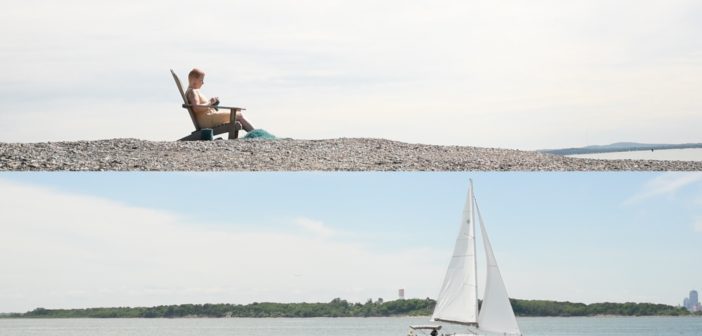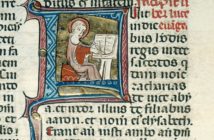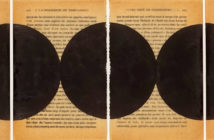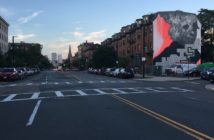The question of documentation is rooted in the history of the avant-garde. Think of Dadaist or Surrealists recording their work via sound or the nascent technology of film. Think of Hans Namuth filming Jackson Pollock as he dripped his paintings on the studio floor. Documentation assumed a new urgency as performance and body art emerged as powerful practices in the late 1950s and 60s.
By the 1970s, Mobius founder Marilyn Arsem very consciously considered how her work would be documented. Early in Arsem’s career, writes Edward Saywell in his essay included in “The Performance Art of Marilyn Arsem,” she focused on how “you capture for review at a later date the layered complexity of the work in the moment of its live performance, both in regard to the actions of the performer as well as to the varied nuances of feeling and reaction from viewers present during the work’s live enactment?”
Art in Service began as a conversation on how we can better understand and cultivate socially engaged practices. Three facets emerged through which to explore these practices: audience, quality, and documentation. As an editor of this publication, which strives to serve as a “living document” of art making in Boston, I am particularly interested in how art and time-based work can be recorded or documented. So I asked four people engaged in documentation in various forms, Sue Murad, Bonnie Bastien, Sarah Rushford, and Risa Horn, about their approaches. What follows are their insightful, generous responses to my query:
How do you each approach the act of documenting an artist’s work? How do you understand the relationship between that artist’s work and your approach to chronicle, archive, digitize, mediate, or describe it?
Sue Murad: Nice to meet you all through your websites. Risa, I’d like to live inside your still images. Bonnie, thank you for posting the Until the Quiet comes…I had seen Close your Eyes awhile back and then, so moved, watched it more times than I can remember. Sarah, so many lovely text projects, and as a lover of objects, I paused for awhile at the Care Tag. Ortega y Gasset--when looking at current projects, I was happy to see McMillan's work and read about their new piece (and see that Sarah, you curated it.) Murray McMillan is one of the most generous artists (in kindness and information) I’ve talked with about film and installation.
When I enter a conversation with an artist about their work and consider how it might become film, the initial sense I have is one of expectancy. I am being presented with new materials from a source I am curious about.
I have two types of films I am currently making. The first is your standard gig; an artist needs a work filmed for archival or promotional purposes, inviting me to film, minimally edit, and hand off. The film acts as a framed wide angle mirror and is beneficial as record, critique, and archive.
This, at least, is how I think of the recorded documents of my own time-based performance and installation work. Sometimes the camera is welcome during the piece and other times filmed before or after.
The second type of film is a collaboration between the work an artist has made and my experience of the piece, of them, and of their greater body of work as context. My approach to observing shifts from highlighting something that is happening and will soon be past, to a visual language that says, this, now. The medium of film offers a type of reflected eternal present, an opening into a second reality and a second time.
The projects I reference here were all durational performance and live action works, each occurring over 1-2 days. They were initially conceived and performed as live actions that then, through our conversations and invitation into collaboration, became works of film. Each film is then a work from work. Two expressed visual languages, one through the other. No money exchanges hands and we share ownership of the finished piece. I’ll be primarily referencing this latter way of filming in the rest of this conversation.
Bonnie Bastien: My approach to this question is from the angle of a cultural producer working in concert with an artist throughout the visioning, research, and creation or performance of the artist’s work. With the Public Library of Brookline Artist-in-Residency (AIR) program, the artist begins their residency with only a rough plan of what they’d like to pursue during the 5 months in the library’s public space. They conduct their research and true visioning work during the residency, which makes it difficult to predict exactly what the end product will be. In this context, the artist’s research and making process is documented as well as the finished product, happening, or performance. Process images, video, and/or bits of the artist’s research and writing are presented publicly through social media, our website, and our email list from the beginning of the residency. A large part of my job is to, in collaboration with the artist, create a voice for the project through the program and to ensure consistency in the narrative of the artist’s process. We hope that making this information available in these early phases creates additional points of entry into the work for our audience and a way to understand how the finished work came to be. It sparks interest in the work early on that may take months to complete or may unfold slowly over time.
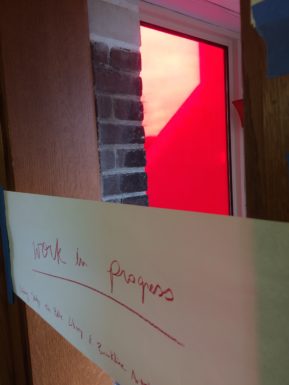
From Liz Nofziger's Ruby Carrel piece for the Brookline Library AIR program. Courtesy of Liz Nofziger, 2016.
The Brookline Library program is brand new. In fact, right now we are in the middle of our pilot year, so how we document the work is an ongoing experiment that grows and adapts as we meet new challenges. How we will document the finished results of the AIR artists’ work and archive the 5-month residency as a whole is still to be seen. We have the great benefit of working with the Brookline Library reference staff (our partners in this program) to devise that plan.… I will also be taking copious notes during this discussion!
Sarah Rushford: I’m thinking of this question from the point of view of a curator and organizer of art events and as an artist and writer.
The question brings me back to a recent moment when I was photographing artist Libby Rowe after she did a performance called Broached Topics at an event I organized. In the performance, Rowe puts on hundreds of pieces of jewelry including many dozens of necklaces. She wanted me to photograph her wearing them all, just after the performance, but it was a great burden for her to keep the jewelry on, and it was very very hot. After I photographed her I helped her take off all the necklaces which had become crossed and caught on one another. While I undid them she had to really work hard to remain calm and not freak out from the practically-strangled feeling she had from wearing them. The photographs I took really show her sweating, looking stressed and holding a great burden. She also looks very proud in them. I felt a real privilege photographing her and helping her off with the jewelry. I thought of it as an extension of her performance and the process enriched of all the meanings her performance.
Documenting artwork feels like a privilege. It's as if the process of documentation amps up the presence of the work and makes me feel more appreciative of its rarity and meanings. Providing the service of photography and documentation can provide another means of making a meaningful personal connection via art, and it’s a different role than viewer, organizer, or artist.
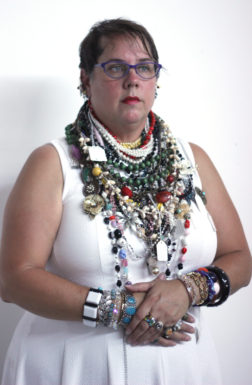
Libby Rowe after her performance of Broached Topics at Changeful, Ortega y Gasset Projects Aug 13, 2016. Courtesy of Sarah Rushford.
When documenting my performance work I find that using an actual object as a document can have more power than a photograph or video. In the case of my piece Jayne Telephones, where a book is read aloud by the performers, the object I use is a handmade artist’s book and showing it as a piece of art in itself that also refers to the work as a performance brings the reality of the performance into the gallery. It's an indexical link to the performance. I've also presented an audio recording of the performance because the audio really brings the viewer close to the text of the performance, literally puts it right up close to them, up to their ear.
Risa Horn: I am thrilled to have the opportunity to have this kind of conversation with you, some of whom I’ve critiqued with before, others of whom I’ve heard about and some of whom I’m having the opportunity to meet for the first time. I am incredibly grateful to be able to participate in an evolving dialogue around these topics with folks for whom I have a great amount of respect.
In 2014/2015 I was an Artist in Residence on Dudley Street under the auspices of the Fairmount Cultural Corridor, during which I spent a lot of time experimenting through trial and error with how to document the various kinds of process, projects, and partnerships that were unfolding. This work is greatly informing my response to this question. Currently, I am working on some projects that have a more traditional client relationship dynamic, where in others the line between documenter and collaborator is much less distinct.
I think about my role in a very similar to how Sue articulated her role: the role of a collaborating artist. I’ve directly addressed some of Sara and Bonnie’s thoughts, but I also feel a lot of kinship with Sue’s thoughts.
I am an interdisciplinary artist, so I am often choosing between multiple tools or approaches when partnering on documentation projects. Personally, I like the challenge of using the simplest, most straightforward use of media to open a window into the work where the second wave audience (the audience experiencing the work solely through documentation) can have access to the elements of discovery and reflection that unfold as one witnesses a piece.
In response to your question, Leah, my first steps in documenting an artist’s work is to talk with the artists I’m working with about the project and listen. Sometimes I take notes, sometimes I don’t take notes. I ask questions, listen, dig, we laugh together, listen more closely. Dedicate the first step of the process to understanding as much as possible about the work. What are the ideas that they are working with? What conceptual and aesthetic choices have they prioritized? What are they hoping to convey through the documentation? I find myself coming back to these few lines over and over again while documenting something, an event or a performance. This mental repetition guides my instincts and shapes the story I tell.
Before making decisions about how or what my tools and approach will be when documenting a work, I want to understand as much as I can about the work, the artist, and the process. After indulging in a real conversation, a conversation between collaborators, a conversation with questions and answers, many decisions make themselves or a path forward seems obvious.
When choosing an approach, I often begin to think about what mediums and strategies might be a good fit for the project as I talk with the artist. Even against my best efforts to just listen, a comment often inclines me in one direction or another. Frequently, my own current artistic explorations also influence my approach. As I reflect, it seems logical that my latest explorations often inform what feels like the freshest and most vital artistic method for capturing the pieces. I’m an interdisciplinary artist, so I often don’t feel like I’m deciding between photography or video or an object, but how and when to use each. I see the relationship between my approach and the work of the artist as one about support and framing through choosing what to capture.
I’m curious and experimenting with using different methods of using video, still images, audio and physical objects (until now, mostly limited edition runs of printed books What is the audience we are creating the document for? If it is a gallery audience or one-on-one conversations, I have found that books feel valuable and transportive. For many of the socially engaged works I’ve been involved with, not everyone who will later want to experience the work can be present at the event. Often having a digital document ensures that this second wave audience has an opportunity to see work and the large group of stakeholders have tools with which to talk about and independently share the work.
Reference system in libraries are fascinating for the way that they are able to documents how an object references numerous topics, ideas, and timelines. Bonnie, I would love to be a fly on the wall in your discussion with reference librarians about how to create a living (searchable?) database a to house the documentation. A system that can acknowledges and account for the complexity of works, creating the possibility for greater access to it subtleties and meaning to different artists.
BB: YES! I am really excited to harness the awesome power of the reference librarians in the ways that you have described. The Brookline Library staff, Sara Slymon (the Library’s director), and the Friends of the Brookline Library (our funders) have been immensely supportive and open to our possibilities. I am enjoying heading up the Brookline Library AIR program immensely.
Regarding your mention of recording process in real time and trying to project a narrative to an audience, you are right. It’s certainly not perfect or comprehensive. The line is not straight from the research, idea generation, and experimentation phases to the finished work, but I think that is o.k. One can never know where an idea is going, but this process can capture a bit of it and helps to build an audience, which is necessary in the context of this AIR program. I expect that this documentation experiment of mine will serve some artists better than others, but that’s the way it goes. Then we move the experiment forward with some new and better idea.
Risa, you hinted at a topic I wonder about often. How can one approach documenting a piece of work and the conversations surrounding it without influencing how the work is viewed by the second wave audience, as you refer to them? Is this a challenge that any of you come upon regularly? Perhaps that’s a difficult question to answer without having a specific artwork in mind.
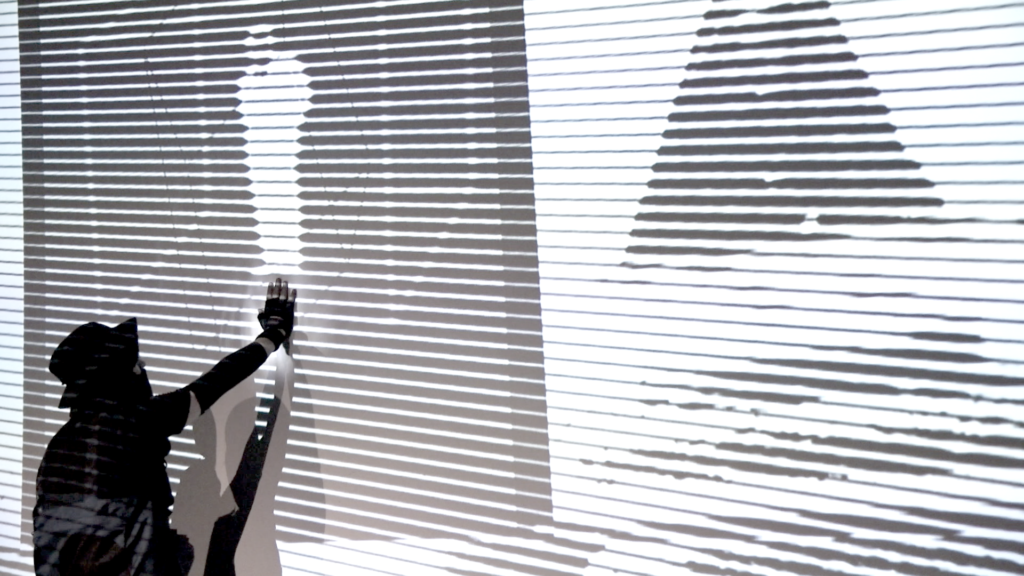
Obscurus Offero. Courtesy of Sue Murad.
SM: Yes, when I make any kind of a record of a piece, I will inevitably be making a second work with a point of view, because as much as I may want to be free from influencing a work, to document is to edit. Whether it is the visual framing of a camera, or the memory embodied in an object as Sarah has done, or Risa’s time lapse, or how Bonnie is gathering process, our framing choices shape the way a second wave experiences the work. We choose from options of how to carry an action happening in time into a new medium, a body, distinctly separate from it’s original live experience and I think this transition can be both a benefit and detriment, depending.
This conversation has helped me name something about my own process and approach to my collaborative performance films. I am clearly more creatively energized to document the piece than the performance. I want to get as close as I can to the content and essence of the live work, and end up lessening the reference that it was a performance, with an audience.
An example of this can be seen in the film, Obscurus Offero, where I follow Vela Phalen, Alice Vogler and Dirk Adams in a live action work taking place in the ICA Foster Prize exhibit. During the 6 hour durational piece, Obscurus Commoneo, I found I consistently avoided including any visual information that referenced the venue. Even the walls I avoided, unless action was happening against them. Although the focus of the work’s activity centered around the Mexican folk legend, Jesús Malverde, for me, the center of the experience was Vela, Alice and Dirk, their shared quiet synergy, and their reverent attention through expressed actions. As they attended Malverde, I attended them.
The opposite feeling about venue occurred when I was filming Meditations on the Tide, a work with Samantha Fields on George’s Island. We filmed on the beach for 2 days, observing her knitting as the tide came in and unknitting as the tide went out. The location was at first to be seen through long shots of the the tide, paralleled in a split screen with Samantha knitting and un-knitting. However, while on the island, as my senses got accustomed to the place, the way your eyes do when entering a dark room, my camera soon turned to the rest of the landscape, the sky, the shadows, the visitors arriving and departing, and on different viewpoints of Samantha herself. When I felt that we had satisfactorily captured a tide/knitting moment, I’d say, “So, I’ll be right back!” And I’d head off to film the other happenings on the island. Initially unclear of what I was going to do with this footage that felt quite different than the initial plan, I sensed that I’d know once I began editing. I was a little nervous to show Sam, as this new footage was now about half of the film, and yet I saw it effectively, even profoundly, serving the content and spirit of the piece. So once, again, less about the work as performance - and more about the work as a piece. The film is now populated with all the reality that is in motion and at rest on a summer’s day on a Boston Harbor Island, with Samantha and the tide, steadily keeping (and letting go of) time.
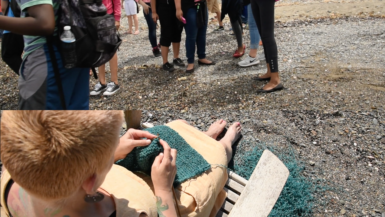
Samantha Fields, from Meditations on the Tide. Courtesy of Sue Murad.
One of the challenges in my most recent performance film, A Visitors Guide to Reorientation to Spectacle Island with Maria Molteni and Hermione Spriggs, was how to document a work that was on the one hand mythic and imaginative, and on the other, full of encyclopedic information? In what way might film, in image and audio, both accent and merge these two realities? Ultimately, I found myself exploring what my camera was capable of as much as I explored the their actions and the landscape they moved through.
The process reminded me of C.S. Lewis in Perelandra, when he writes, “And now, by a transition which he did not notice, it seemed that what had begun as speech was turned into something that can be remembered as sight, or into something that can be remembered only as if it were seeing.”

